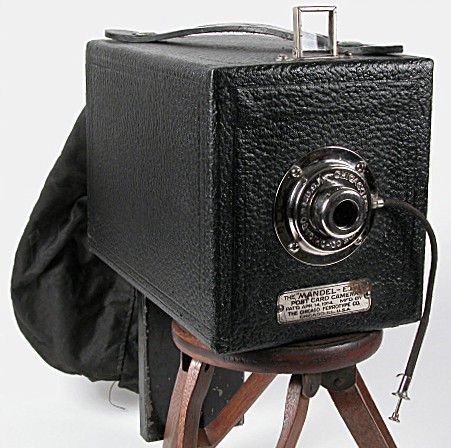
Mandelette Mounted on a Tripod

The Mandel-ette Postcard Camera, manufactured by the Chicago Ferrotype Company of Chicago, Illinois USA, was introduced ca 1913. Apparently time has changed this camera's name to Mandelette. The hyphen has been dropped in modern usage.
This direct-positive camera with attached developing tank was marketed to street, or itinerant photographers. It produced photographic postcards on 2 1/2 x 3 1/2 inch direct-positive paper. The Mandelette and similar street cameras were portable and compact outfits. Due to their built-in processing capability, street photographers could offer the public inexpensive finished photographs on-the-spot.
Street cameras with integrated processing allowed photographers to avoid the expense and complication of maintaining a fixed business establishment. Studio photographers needed to attract the public to their place of business. Advertising was a necessary expense. In contrast, street photographers approached the public. Many street photographers simply stood on busy sidewalks with their camera, tripod and sample photographs on display. The more lucrative locations were beaches, fairs, rodeos - places where people were relaxed, having fun, ready to spend a small sum on impulse purchases, and open to the idea of taking home a remembrance of their good times.
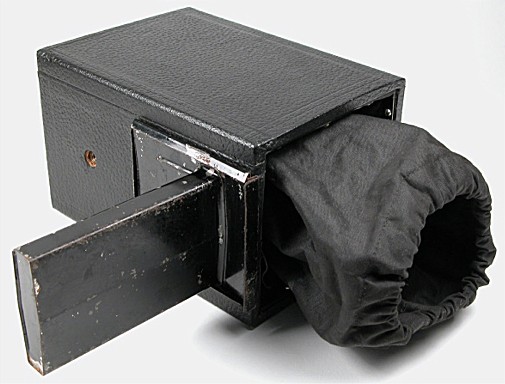
The Mandelette is shown on its side. The camera body is made of leatherette covered wood. The developing tank can be seen protruding from the bottom. The black cloth extending from the back is a light-tight sleeve that allows the photographer to place his hand inside the camera body. With his hand in the sleeve the photographer places a stack of unexposed postcards in the camera and then moves one of the cards into position for exposure. After exposure the postcard is dropped through a slot into the tank for development. The developed photograph is removed from the tank with the print lifter and withdrawn through the sleeve.
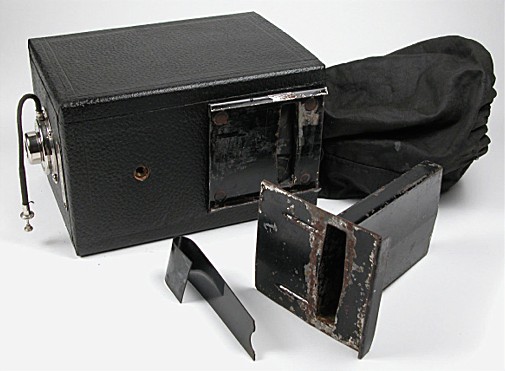
To fill the tank with developing solution it must be detached from the camera bottom. The curved black object, probably made of hard rubber, is the print lifter. The print lifter was used to pull the developed postcard out of the tank. Complete camera outfits, with an intact sleeve, tank and lifter are more difficult to find than partial outfits.
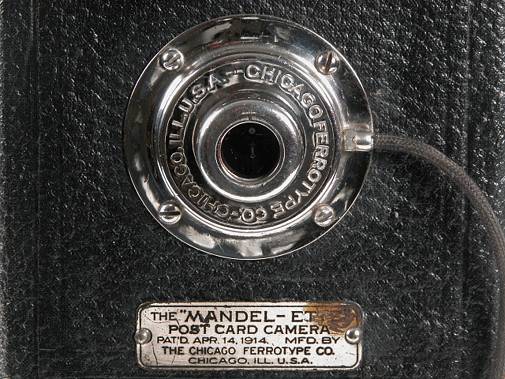
The Mandel-ette patent application was filed in 1913 and granted in 1914. The earliest Mandel-ette advertisement I've been able to locate dates to 1913. Over a period of decades, Chicago Ferrotype Company manufactured a variety of direct-positive street cameras, all capable of producing a finished photograph within minutes. Depending upon the model, Chicago Ferrotype cameras could create prints, postcards and tintypes in a wide range of sizes. Certain models could create button style paper direct-positives and tintypes.
The Mandel-ette and Mandel model cameras were named after the company's founders, Louis and Mandel Mandel.
The Mandelette shutter offers a single instantaneous speed and is tripped via a non-removable cable release. The lens is a fixed-focus, fixed-aperture meniscus. The camera is aimed using a small foldable Newtonian optical viewfinder. The Mandelette was designed to be used outdoors on fairly bright days, mounted on a tripod.
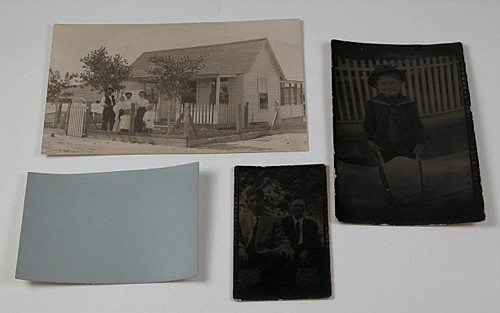
At top left is a postcard measuring approximately 3 1/4 x 5 1/2 inches. This was considered the standard or most common size for USA photographic postcards. Clockwise, to its right, is a Mandel postcard measuring 3 x 4 1/2 inches. Next is the smallest of this group, a Mandel postcard measuring 1 3/4 x 3 inches. Bottom left is an unexposed Mandelette postcard measuring 2 1/2 x 3 1/2 inches.
Notice the difference in print tones between the image of the family in front of their home and the two Mandel images. The postcard of the family is not a direct-positive image. It was created by the negative-positive method. Prints produced by the direct-positive method have a muddy, or overall dark appearance when compared to prints made by the negative-positive process.
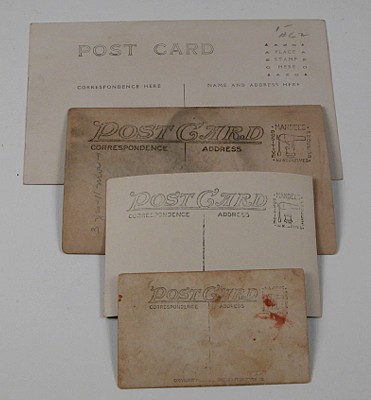
The backs of the four postcards shown earlier appear above. It is readily apparent how the cards differ in size.
It is interesting that the Chicago Ferrotype Company chose to market to the demand for photographic postcards. When the Mandelette camera was introduced photographic postcards were popular with the public. Mandel postcards were an inexpensive and convenient way for people to participate in this fad. That the street photographer could offer a portrait with a postcard imprint must have helped sales, regardless whether the portrait was mailed or not.
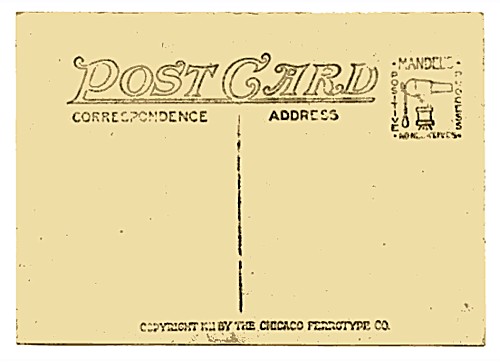
The imprint on this postcard is the clearest of all the Mandel postcards in my collection. This is as good as it gets. The stamp block includes a drawing of the Mandel Wonder Automatic Cannon Photo Button Machine street camera surrounded by the words Mandel's Positive Process - No Negatives. Printed on the bottom of the postcard are the words Copyright 1911 By The Chicago Ferrotype Co.

|
Page created October 22, 2002;
updated December 20, 2020 |